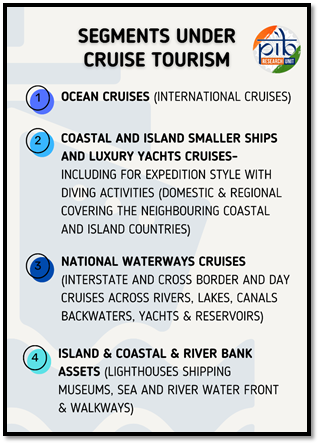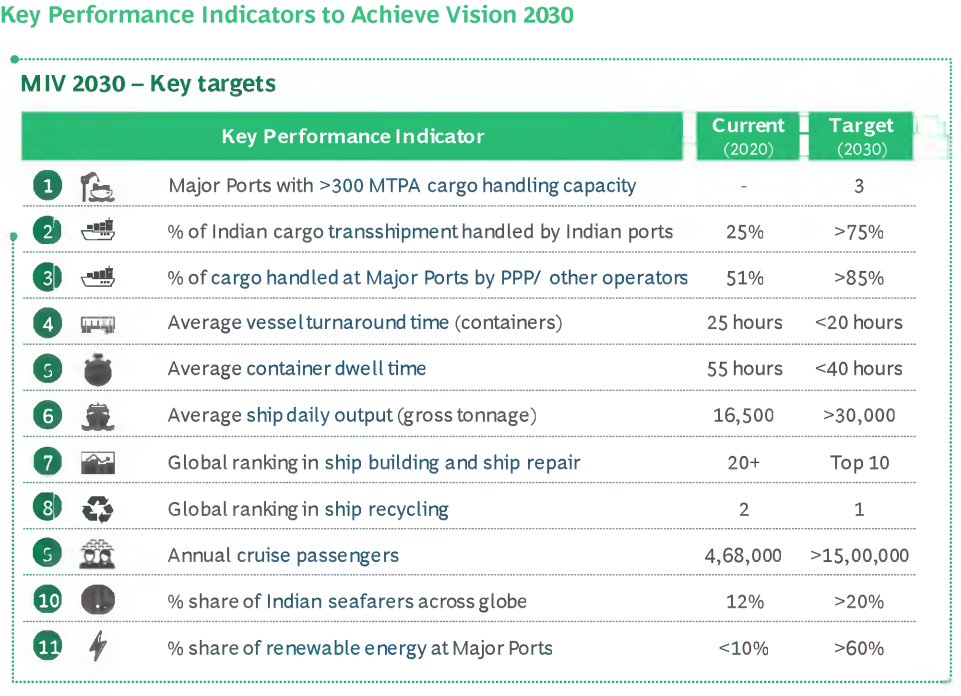Important Facts For Prelims
Cruise Tourism in India
- 26 Apr 2025
- 5 min read
Why in News?
India is boosting cruise tourism through the Cruise Bharat Mission(CBM), Maritime India Vision (MIV-2030), and new IWAI led partnerships, aiming to become a global hub across rivers and coasts.
What are the Key Facts Related to Cruise Tourism?
- Cruise Tourism: It is a form of leisure travel that combines travel, hospitality, and sightseeing via ocean cruises (on seas) and river cruises (on inland waterways), offering a unique leisure experience.
- India's Natural Advantage: India has a 7,500 km coastline, 12 major and around 200 minor ports, and 111 National Waterways covering over 20,000 km of navigable rivers and canals.
- Over 1,300 islands and coastal states boost India’s oceanic and inland cruise tourism potential.
- Recent Developments in River Cruise Tourism:
- Yamuna (Delhi): MoU signed in March 2025 between IWAI and Delhi Govt to develop a 4-km eco-friendly cruise on NW-110 using electric-solar hybrid boats.
- Jammu & Kashmir: MoU (March 2025) signed for cruise development on Chenab (NW-26), Jhelum (NW-49), and Ravi (NW-84).
- Madhya Pradesh & Gujarat: Cruise services launched on Kukshi–Sardar Sarovar route under a tripartite agreement.
- River Cruise Tourism Roadmap 2047: Launched at first Inland Waterways Development Council (IWDC) as part of Maritime Amrit Kaal Vision 2047, focusing on 4 pillars- Infrastructure, Integration, Accessibility, and Policy.
What are India's Initiatives to Promote Cruise Tourism?
- CBM: CBM was launched in 2024 to transform India into a leading cruise tourism destination by 2029.
- Led by the Ministry of Ports, Shipping, and Waterways, it targets doubling cruise passenger traffic by 2029 from 4.71 lakh in FY 2023–24.
- Implemented in 3 phases (2024–2029), the mission includes terminal development, digitalization, decarbonization, and regional alliances (UAE, Maldives, Singapore).
- A National Cruise Infrastructure Master Plan for 2047 and initiatives like e-visas and e-clearance aim to enhance connectivity and tourism.
- MIV: MIV, 2030 aims to make India a key global cruise tourism hub with an 8x growth target over the next decade.
- It focuses on oceanic, coastal, island, and inland cruise development.
- Focus on River Cruise Tourism: River cruise tourism is an emerging sector utilizing India’s biodiversity and cultural heritage. The Inland Waterways Authority of India (IWAI) is developing navigation infrastructure, terminals, and heritage circuits along rivers like the Ganga, Brahmaputra, and Kerala backwaters.
- India also promotes transnational cruises through the Indo-Bangladesh Protocol (IBP) route.
- A major highlight is the MV Ganga Vilas, the world’s longest river cruise, launched in 2023, and listed in the Limca Book of Records.
- India also promotes transnational cruises through the Indo-Bangladesh Protocol (IBP) route.
What is Inland Waterways Transport?Click Here to Read: Inland Waterways Transport |
UPSC Civil Services Examination, Previous Year Question (PYQ)
Prelims
Q. In the context of proposals to the use of hydrogen enriched CNG (H-CNG) as fuel for buses in public transport, consider the following statements: (2019)
- The main advantage of the use of H-CNG is the elimination of carbon monoxide emissions.
- H-CNG as fuel reduces carbon dioxide and hydrocarbon emissions.
- Hydrogen up to one-fifth by volume can be blended with CNG as fuel for buses.
- H-CNG makes the fuel less expensive than CNG.
Which of the statements given above is/are correct?
(a) 1 only
(b) 2 and 3 only
(c) 4 only
(d) 1, 2, 3 and 4
Ans: (b)







